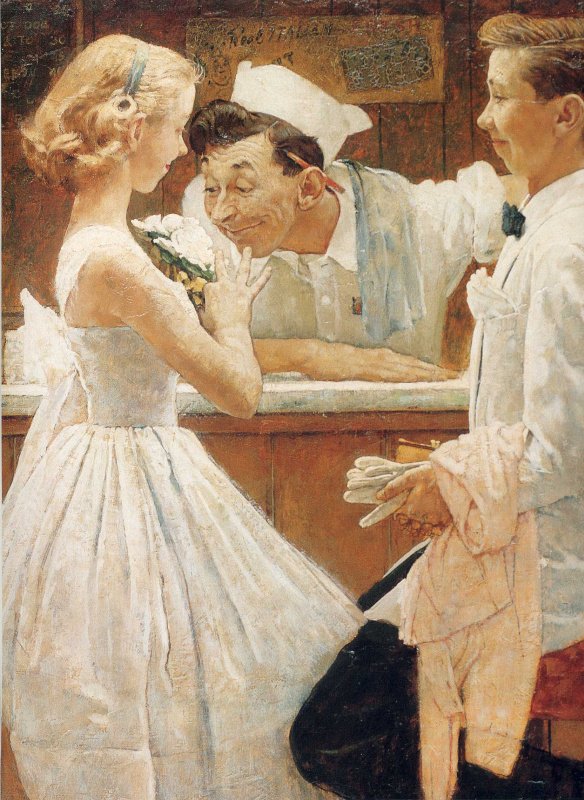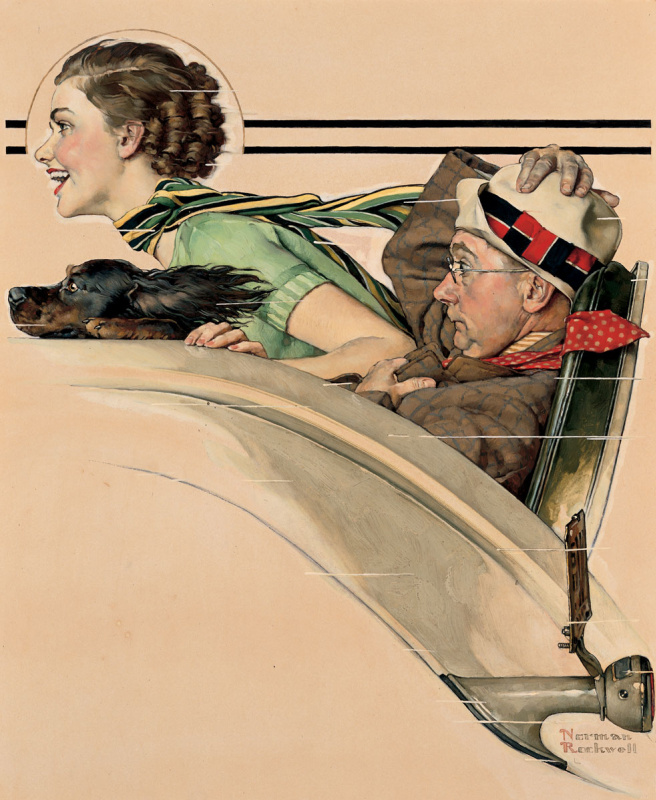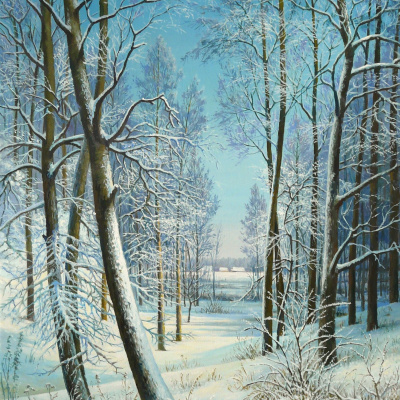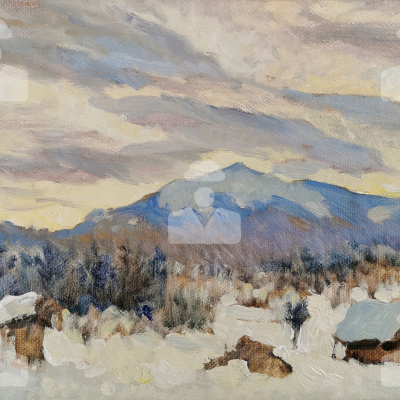One of the iconic artworks by Norman Rockwell, "Shuffleton's Barbershop" (1959) was sold by the Berkshire Museum for around $25 million. The Lucas Museum of Narrative Art in Los Angeles, with its co-founder, Star Wars creator George Lucas, saved the Norman Rockwell painting that has been at the center of a legal storm.
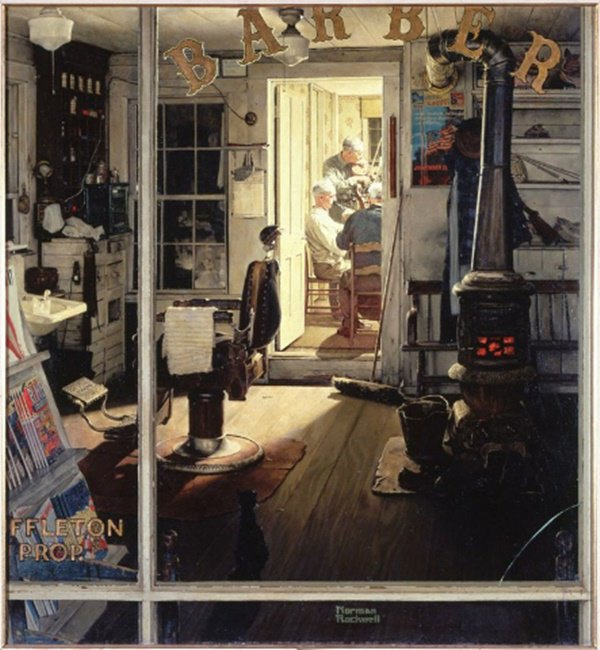
Painted in 1950 as a cover for The Saturday Evening Post, "Shuffleton's Barbershop" is one of Rockwell’s most popular works. Mr. Bacigalupi, director of the Lucas Museum, sees it as one of his most complex compositions as well: a glimpse into small-town life after business hours, which doubles as a reflection on the history of painting, rife with "references to modernism" like the prominent windowpane structure that echoes a Mondrian grid.
Norman Rockwell’s "Shuffleton's Barbershop" is considered to be the artist’s most valuable and recognized piece of art. George Lucas Museum saved the Rockwell masterpiece from the financially troubled and legally scrutinized Berkshire Museum in Western Massachusetts.
Norman Rockwell’s "Shuffleton's Barbershop" is considered to be the artist’s most valuable and recognized piece of art. George Lucas Museum saved the Rockwell masterpiece from the financially troubled and legally scrutinized Berkshire Museum in Western Massachusetts.

FACEBOOK: BERKSHIRE MUSEUM
The painting was originally donated to the Berkshire Museum by Rockwell, making a controversy that erupted last year over its deaccessioning even fiercer than the usual public backlash. The Berkshire Museum had planned to sell the painting in a major November sale at Sotheby’s, where it was estimated to bring $20 million to $30 million. But two lawsuits, including one from a group including Rockwell’s three children, were filed to prevent this auction as well as the de-accessioning of several other museum works, and the Massachusetts attorney general obtained an injunction to stop any museum sales while examining their necessity and legality.

Protesters at the Berkshire Museum in November, upset over a planned sale of dozens of artworks, including the Norman Rockwell painting. CreditStephanie Zollshan/The Berkshire Eagle, via Associated Press
It was at the center of a legal fight over the Berkshire Museum’s planned art sale. The artist’s son, Peter Rockwell, fought hard to keep it in the public eye. This painting is Peter’s favorite. "Both because of the way I felt about the painting and because my father gave the painting to the Berkshire Museum before his own museum was started so he had no public collection and he wanted it in the public where people could see it."
The sculptor remembers watching his father work long days and nights dedicated to his craft. "When he was alive his work did not sell for very much. It is important to emphasize the public element of a museum’s collection." It was no surprise that Lucas, a collector of Rockwell’s artwork, would step in to preserve the painting.
The sculptor remembers watching his father work long days and nights dedicated to his craft. "When he was alive his work did not sell for very much. It is important to emphasize the public element of a museum’s collection." It was no surprise that Lucas, a collector of Rockwell’s artwork, would step in to preserve the painting.
"The fact that it’s a barber, but then in the back there are people playing what looks like classical music, so it’s a contrast between what we normally think of a barber and what we think of classical music. That makes it interesting."
The museum’s founder, George Lucas, of "Star Wars" fame, is already known as the leading private collector of Rockwell’s work. He owns dozens of Rockwell paintings, most of which are promised gifts to his museum.
The Lucas museum’s seed collection includes multiple works by Rockwell, and mentions the artist prominently in its promotional materials. The collection consists of 13 paintings and eight studies by the artist. Among the paintings are "The Gossips" (1948), "After the Prom" (1957), "River Pilot" (1940) and "Couple in Rumbleseat" (1935). Another person known to collect works by Rockwell, the film director and producer Steven Spielberg, recently joined the board of the Lucas museum.
The Lucas museum’s seed collection includes multiple works by Rockwell, and mentions the artist prominently in its promotional materials. The collection consists of 13 paintings and eight studies by the artist. Among the paintings are "The Gossips" (1948), "After the Prom" (1957), "River Pilot" (1940) and "Couple in Rumbleseat" (1935). Another person known to collect works by Rockwell, the film director and producer Steven Spielberg, recently joined the board of the Lucas museum.

Lucas was identified as the person who paid $46 million when another Rockwell work, "Saying Grace," came up for sale in 2013. That was the highest price paid to date for a Rockwell work.
Left: Norman Rockwell. Saying Grace, 1951.
"We are very excited to have it join our collection," said Don Bacigalupi, director of the Lucas Museum. "This will be one of the anchor works of our museum, which we’re delighted to share with the public."
Lucas Museum of Narrative Art finally broke ground last month in anticipation of its 2022 opening. The museum will be located in Exposition Park, which is already home to the Los Angeles Memorial Coliseum, the California Science Center, and the Natural History Museum of Los Angeles County. It will also feature art and artifacts from George Lucas’s personal art collection, which is heavy on 20th-century American work and Hollywood artifacts, particularly from his beloved Star Wars franchise.

A rendering of the George Lucas Museum of Narrative Art. Courtesy of MAD Architects.
According to MAD Architects, the Los Angeles museum’s designer, the $1.5 billion project is meant to suggest that "a futuristic spaceship" has landed on its 11-acre site, located near other museums and the University of Southern California campus.
The Lucas family expects to provide at least a $400 million endowment for the museum. The collection will present works in three categories — narrative art, the art of the cinema (including outtakes from the filmmaker’s projects, including "Star Wars") and digital art.
The Lucas family expects to provide at least a $400 million endowment for the museum. The collection will present works in three categories — narrative art, the art of the cinema (including outtakes from the filmmaker’s projects, including "Star Wars") and digital art.

The George Lucas Museum of Narrative Art. Courtesy of MAD Architects.
Later this year, the painting will go on display at the Norman Rockwell Museum in Stockbridge for up to two years (until 2020), since the Lucas Museum isn’t expected to open until 2022.
The saving grace in this story is that the iconic painting won’t be sent to a private collector or a galaxy far away. It will be on public eye as the artist himself wanted.
The saving grace in this story is that the iconic painting won’t be sent to a private collector or a galaxy far away. It will be on public eye as the artist himself wanted.
Based on materials from NY times, Berkshire Museum’s official site, Artnet and other resources.
Title illustration: Norman Rockwell, Shuffleton’s Barbershop (1959). Courtesy Berkshire Fine Arts.
Title illustration: Norman Rockwell, Shuffleton’s Barbershop (1959). Courtesy Berkshire Fine Arts.
















